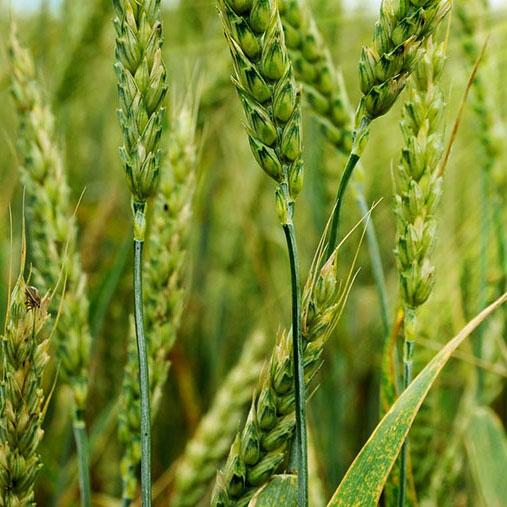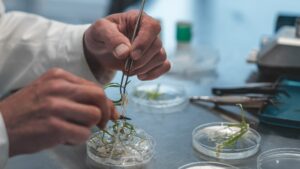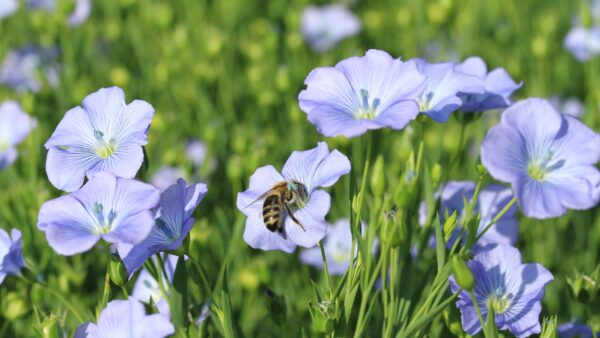The implications of massive industry changes, from biological products and company mergers to the end of patent protection of several major active ingredients
In the first part of this three-part series, we looked at the historical and recent evolution of crop protection. In part two, we examined the challenges in creating crop protection products. In this final piece, we present current trends and future outlook.
Top trends in crop protection product development
BIOLOGICALS
One of the fastest growing areas of R&D among crop protection companies is biologicals. “These are becoming increasingly important for all farmers – organic and conventional – to employ as part of their integrated pest management (IPM) strategy,” notes Will Surman of Crop Life International.
Alyson Emanuel agrees that the development of biological solutions will continue to be an important trend given the rate of advancement in key dimensions such as scalability and stability. “Biologicals and chemicals can work together to give growers broader protection, an extended application window and better management of resistance and residues,” notes the business head of the Functional Crop Care unit in BASF Crop Protection. “For example, when Serifel (a foliar-applied biological fungicide that is based on the same active ingredient in our Integral seed-applied product) is used in an IPM program along with chemical-based active ingredients, it offers efficient prevention of fungal diseases.”
[tweetshare tweet=”One of the fastest growing areas of R&D among crop protection companies is biologicals” username=”EuropeanSeed”]
Dan Turner, media relations lead at Dow/DuPont, echoes the sentiment. “Seed treatments, where combinations of technologies such as traditional chemistries and biologicals are helping growers, both improve crop emergence and plant vigor,” he says.
Head of External Communications at Bayer’s Crop Science division, Utz Klages, also predicts the launch of more biological products as well as the introduction of new high-performing chemical crop protection products in the future, which benefit growers and the food value chain through even better produce quality and environmental sustainability. The firm is working on the discovery and development of several new bacterial and fungal solutions for pest/disease management and increased crop efficiency. In addition, Bayer’s Biologics Group in West Sacramento, California opened a new lab space for biologics development in September 2017. The ‘Crop Science CoLaborator’ is the third ‘incubator’ space that Bayer has offered to start-up companies to help develop their technologies. One other major recent Bayer biologicals investment is the founding of a new company with biotech startup Ginko Bioworks. It will concentrate on technologies to improve plant-associated microbes with a major focus on nitrogen fixation. This, Bayer believes, may enable a major leap in plant physiology – producing nitrogen fertilizer directly in the plant – which would significantly minimize agriculture’s environmental impact.
One exciting example of a delivery system for biologicals has been commercialized by Bee Vectoring Technology of Mississauga, Ontario, Canada. It has applied for patents in Chile, Japan and the USA for its system, which causes bees to pick up biological agents on their legs as they leave commercial hives on daily visits to field crops.
Turnerbelieves improved delivery systems will play a very important role in the future, as well as the use of IPM. He believes that companies that can, for example, address pests with native traits, seed treatments and foliar treatments will be able to provide integrated solutions which reduce the likelihood of resistance development, improve consistency of control, and meet local circumstances with flexibility. He believes companies that can build this integrated solution mindset will be the innovators of the future.
Brian Carroll is also of the view that an integrated use of multiple approaches will continue to grow in importance in pest and disease management. “Overusing any one tool, no matter how well that tool works, can lead to resistant weeds,” notes the European external communications manager for Monsanto. ”So, implementing multiple crop protection methods is critical. We encourage farmers to use diverse practices including cover crops, tilling, crop rotation and correct planting timing.”
Gerardo Ramos, senior advisor in crop protection development at Syngenta, adds that the invention and development of novel products based on modern agrochemicals but targeting more holistic product concepts (concepts that consider other parameters beyond potency and spectrum) combined with steady progress in formulation and delivery technologies, will continue to be a major source of innovation in the crop protection products sector.
PUBLIC TRUST
The issue of public trust in science and food production is here to stay. Trends in crop protection product regulatory requirements and legal frameworks, observes Ramos, are intimately connected to societal and political desires for greater protection of humanity and the environment. However, he also notes that the increasing disconnection between urban and rural populations, mostly in developed and fast-developing emerging markets, creates requirements towards provenance and higher food quality, it also leads to a distorted perception of the risks and benefits of agricultural technology. “As a consequence, the growers and the agriculture industry supporting sustainable food production are facing huge pressure to invent and use new technologies to solve many issues,” he says. “The global rural economy and the scarcity of key resources like water and arable land for food production also creates a noticeable demand for new cropping and crop protection technologies. This is particularly relevant for the emerging markets development like China, due to the size and the rates of development of its population.”
[tweetshare tweet=”The increasing disconnection between urban and rural populations, mostly in developed and fast-developing emerging markets leads to a distorted perception of the risks and benefits of agricultural technology” username=”EuropeanSeed”]
DIGITAL AND TECHNOLOGICAL ADVANCES
The increasing use of many online, sensing and data analysis technologies is another huge current trend in crop protection. They continue to help farmers to be more precise in their diagnosis of crop problems and greatly increase efficiency in the use of crop protection products. Ramos notes that the development precision application and other new technologies are being driven by some of the increasingly challenging regulatory thresholds on toxicological and environmental impact of crop protection products.
He adds that although the pace of technological change continues to increase, the characteristics of agriculture make the development of solutions extremely costly and time-consuming, so the ability to extract value from existing extremely large (and continuously growing) volumes of data, and to use it in models, will become increasingly important. “Machine learning and data analysis from weather, yields, imaging and so on will be deployed in many applications,” he predicts, “to enable growers to continuously optimize value creation at planting and post-planting phases.” One example of this, points out Matthias Nachtmann, digital farming & Maglis Team lead at BASF Crop Protection, is using a smartphone picture of powdery mildew with a science-based forecasting algorithm to ensure yield goals are met. BASF is working with interdisciplinary teams as well as with internal and external experts to develop new technologies to allow farmers to make better-informed decisions. One example is Maglis, an online crop management platform launched by BASF in early 2016.Turner also believes the use of data analytics to understand where, when and how treatments are required will continue to increase, as will the use of drones for both scouting and treatment.
[tweetshare tweet=”The use of data analytics to understand where, when and how treatments in agriculture are required will continue to increase, as will the use of drones for both scouting and treatment.” username=”EuropeanSeed”]
RNA AND DNA
Surman points to another likely trend in the crop protection industry: increased use of RNA Interference (RNAi). It’s a naturally-occurring process that can accomplish several things, including prevention of disease. Two examples are the creation of ringspot virus-resistant papayas and orange trees that resist a disease called citrus greening. The process involves RNA molecules inhibiting gene expression, and thereby inhibiting production of one or many of the proteins responsible for the development of a disease or essential for a pest’s survival. “RNA-based technologies can also benefit crops in other ways, from the reduction of undesirable traits, to improved quality and nutrition,” Surman notes. Some examples already commercialized are non-browning apples, nicotine-free tobacco, decaffeinated coffee and soybeans with less saturated fat. There is also current RNAi research into producing crops with lower levels of natural toxins, such as gossypol in cotton seeds and linamarin in cassava plants, as well as nutrient-fortified and hypo-allergenic crops.
[tweetshare tweet=”RNA-based technologies can also benefit crops in various ways, from prevention of disease, and reduction of undesirable traits, to improved quality and nutrition” username=”EuropeanSeed”]
In addition, RNA-based technologies can improve crop performance by increasing stress tolerance, inducing early flowering or delaying ripening or deterioration. Surman adds that they may also be used to develop crop protection products that only affect targeted pests. “For example, an insecticide would be highly targeted to only impact corn rootworm in maize, but not other insects or animals,” he says.
Lastly, Ramos lists genome editing (e.g. CRISPR/Cas9) as a new genetic technique that will increase in use. It will allow the rapid introduction of native traits into various crops and also accelerate the development of transgenic seeds, he says, and “it could also have a great impact in shortening breeding cycles. New hybrid crops like wheat and barley will be game changers.”
IMPROVED PLANT SUPPORT
In Emanuel’s view, improving nutritional support for plants is a growing trend. “Farmers can simplify their use of fertilizers, increase yields and see an improved environment footprint through using nitrogen stabilizers such as Limus, which we recently launched. It improves the amount of nitrogen that plants can use from urea-based fertilizers. In addition, our seed-applied biological inoculants such, such as Nodulator in North America and HiCoat in Europe, are based on delivering nutrition, and therefore increasing yield and plant growth potential, to leguminous plants through nitrogen fixation.”
[tweetshare tweet=”Improving nutritional support for plants is a growing trend as farmers can simplify their use of fertilizers, increase yields and see an improved environment footprint through using nitrogen stabilizers” username=”EuropeanSeed”]
Ramos also foresees technological breakthroughs in plant support, specifically in the area of abiotic stress. “There is a potentially very big market of unaddressed needs in that area, mostly driven by climate change and soil degradation. Technologically, these needs could be addressed by chemicals, traits, breeding technologies or a combination thereof. At the moment, there is no evidence of disruptive breakthroughs in this field but as technology develops in other segments, new solutions may emerge in the mid to long term.”
INDUSTRY MERGERS
Over the last 12 to 18 months, many mergers and acquisitions have occurred in the crop protection products industry. The following companies are now the major players: Bayer/Monsanto, Dow/DuPont, BASF, FMC Corp., and ChemChina, which recently purchased Syngenta.
Smaller companies includeNufarm (Australia), United Phosphorous (India), Sumitomo Agrochemicals (Japan), AMVAC (US) and Albaugh (US). Another is Platform Ag (US), which may merge with one of the larger companies in the coming months.
[tweetshare tweet=”The crop protection industry mergers are bringing new and more innovative solutions to customers in a shorter timeframe” username=”EuropeanSeed”]
BASF says that since the industry consolidation activities are ongoing, it is too early to foresee all consequences for the industry in detail. Regarding Bayer and Monsanto joining forces, Klages says the move is about bringing new and more innovative solutions to customers in a shorter timeframe. “Today, it takes companies like us more than 10 years to develop new crop protection products. And it takes seed companies almost as long to develop (corresponding) plant traits,” he notes. “If both aspects were worked on jointly and in parallel, it would be possible to save a lot of time and give growers – big and small – quicker access to a broad set of solutions to meet their current and future needs, including enhanced solutions in seeds and traits, crop protection, and digital agriculture.” These are expected to result in significant and lasting benefits for farmers: from improved sourcing and increased convenience to higher yield, better environmental protection and sustainability.
PATENT PROTECTION EXPIRATION
According to the AgroPages report ‘New Off-Patent/Generic Agrochemicals 2017-2022,’ 26 agrochemical active ingredients (AIs) will lose their patent protection between 2017 and 2022, including 13 herbicides, 4 insecticides, 8 fungicides and 1 safener.
“Some well-known products like Chlorantraniliprole are in the list, as well as some niche products such as the eco-friendly fungicide Isotianil used on rice,” states the report. “Bayer holds the most (a) products with patents expiring in the coming five years, the same numbers as from Japanese companies.” These are Amisulbrom from Nissan Chemical Industries, Pyrimsulfan from Ihara Chemical Industry, Pyroxasulfone from Kumiai Chemical Industry, Flubendiamide and Pyrifluquinazon from Nihon Nohyaku, Fenpyrazamine and Metofluthrin from Sumitomo Chemical.
[tweetshare tweet=”Patent expiry, allowing generic companies to copy and sell the product (usually at a reduced price), provides a strong incentive for the innovator to keep on innovating” username=”EuropeanSeed”]
In terms of the impact of these developments, Klages notes that “competition from generic manufacturers is a global trend. We at Bayer continue to focus on innovation.” Ramos agrees that when apatent expires, and generic companies are allowed to copy and sell the product (usually at a reduced price), this provides a strong incentive for the innovator to keep on innovating. “Most innovative companies do not only focus on developing new active ingredients, but also exploring new formulation opportunities for optimizing the active ingredient’s performance,” he says. “Patents can be also applied to specific novel manufacturing methods or specific innovative formulations. The originating companies may want to enforce these patents as well.” Ramos adds, however, that if generic companies manage to circumvent patents relating to processes and formulations, products will be able to go to market with a direct impact on the sales of the originating company. “For generic companies,” he says, “it can be an opportunity to ‘renew’ their product portfolio and reduce their dependency on purely commodity products.”













